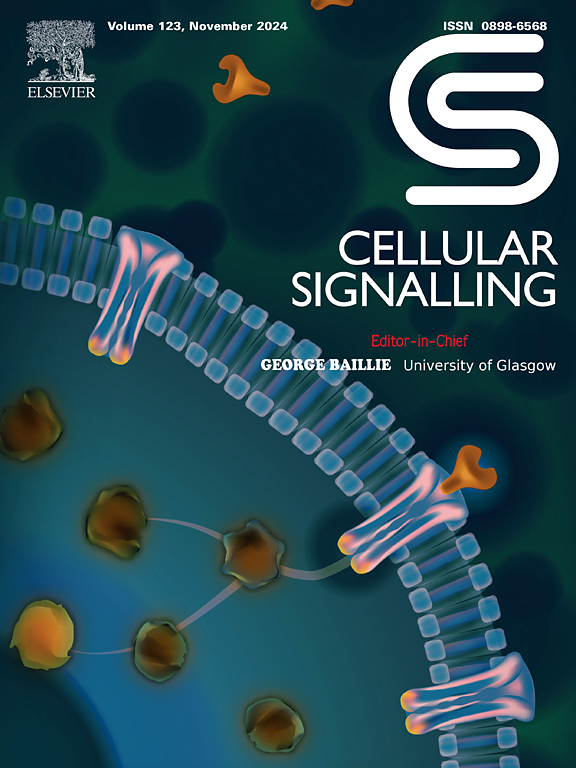Activation of STING pathway by mitochondrial fission negatively regulates adipogenic differentiation of 3 T3-L1 cells
IF 3.7
2区 生物学
Q2 CELL BIOLOGY
引用次数: 0
Abstract
Adipocyte hyperplasia refers to the increase in the number of adipocytes, whereas adipocyte hypertrophy pertains to the enlargement of individual adipocytes resulting from the accumulation of lipid droplets. In this study, we found that activation of the STING signalling pathway occurs during adipogenic differentiation of 3 T3-L1 preadipocytes. Interestingly, inhibiting the STING pathway by using STING antagonist H151 or siRNA targeting STING promotes adipocyte differentiation and increases adipocyte numbers, while activation of STING inhibits adipogenic differentiation. Silencing the STING canonical downstream IRF3, or inhibiting the proton channel activity of STING enhances adipogenic differentiation, confirming the negative modulation of adipogenic differentiation by STING. In vivo, intraperitoneal injection of H151 into mice with a high-fat diet further enhances the adipocyte hyperplasia, as shown by the increased volume of adipose tissues, but consistent sizes of adipocytes. During the adipogenic differentiation of 3 T3-L1 cells, DRP1-mediated mitochondrial fission is enhanced, and causes mitochondrial DNA leakage, which in turn activates the STING pathway. However, inhibition of mitochondrial fission represses adipogenic differentiation of 3 T3-L1 cells in spite of the down-regulation of STING pathway. Therefore, our results indicate that adipogenic differentiation is associated with DRP1-induced mitochondrial fission. However, the leakage of mitochondrial DNA caused by DRP1-induced mitochondrial fission activates the STING signalling pathway, which negatively regulates adipogenic differentiation. Tissue specific reduction of DRP1-associated mitochondrial fission or STING enhancement might be new strategies for the therapy of obesity-associated diseases.

线粒体分裂激活STING通路负向调控3 T3-L1细胞的成脂分化。
脂肪细胞增生是指脂肪细胞数量的增加,而脂肪细胞肥大是指由于脂滴的积累导致单个脂肪细胞的增大。在本研究中,我们发现STING信号通路的激活发生在3 T3-L1前脂肪细胞的成脂分化过程中。有趣的是,使用STING拮抗剂H151或靶向STING的siRNA抑制STING通路可促进脂肪细胞分化并增加脂肪细胞数量,而激活STING则可抑制成脂分化。沉默STING典型下游IRF3,或抑制STING质子通道活性可增强成脂分化,证实了STING对成脂分化的负调节作用。在体内,高脂饮食小鼠腹腔注射H151进一步促进了脂肪细胞的增生,脂肪组织体积增加,但脂肪细胞大小不变。3 T3-L1细胞在成脂分化过程中,drp1介导的线粒体分裂增强,导致线粒体DNA渗漏,进而激活STING通路。然而,尽管STING通路下调,但线粒体裂变抑制了3 T3-L1细胞的成脂分化。因此,我们的研究结果表明,成脂分化与drp1诱导的线粒体裂变有关。然而,drp1诱导的线粒体分裂引起的线粒体DNA泄漏激活了STING信号通路,从而负向调节成脂分化。组织特异性减少drp1相关的线粒体分裂或增强STING可能是治疗肥胖相关疾病的新策略。
本文章由计算机程序翻译,如有差异,请以英文原文为准。
求助全文
约1分钟内获得全文
求助全文
来源期刊

Cellular signalling
生物-细胞生物学
CiteScore
8.40
自引率
0.00%
发文量
250
审稿时长
27 days
期刊介绍:
Cellular Signalling publishes original research describing fundamental and clinical findings on the mechanisms, actions and structural components of cellular signalling systems in vitro and in vivo.
Cellular Signalling aims at full length research papers defining signalling systems ranging from microorganisms to cells, tissues and higher organisms.
 求助内容:
求助内容: 应助结果提醒方式:
应助结果提醒方式:


